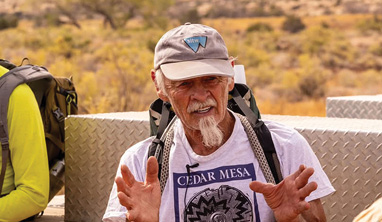Some information may be outdated.
The number of black bears in Utah, including those in the La Sal Mountains, is on the rise, according to the Division of Wildlife Resources (DWR).
That has led to more run-ins with people and increased conflict with domestic sheep and cattle, DWR officials say. As a result, the agency is proposing changes to hunting laws that will increase the number of bears taken each year.
The proposed changes will result in 50-70 more bears being “harvested” during the 2015 season, which will bring the number of bears killed in Utah up to between 300 and 320 statewide.
Leslie McFarlane, DWR mammals coordinator, said in a statement on the DWR website that the state’s black bear population has more than doubled from around 2,000 in the 1990s to an estimated 4,100 currently. As a result, the DWR, and USDA-Wildlife Services, are having to euthanize more bears because they pose a threat to people or kill livestock.
“Hopefully,” McFarlane said, “hunters can help us by reducing the number of bears that come into conflicts and have to be killed for being aggressive.”
Dustin Mitchell, DWR wildlife biologist for Grand and San Juan counties, said that actual bear populations are hard to determine. But the La Sal, Book Cliffs and San Juan units have some of the highest densities in the state, he said.
“We have noticed an increase in bear activity in the La Sal Mountains,” Mitchell said. “Given the increase in bear sightings and incidences this past year, DWR feels that the La Sal bear population can sustain an increase in harvest permits.”
Mitchell said the proposed “harvest objective” for 2015 in the La Sal Mountains is 42 to 48 bears, an increase of 12 to 15 above the 30 to 35 taken annually over the past three years. He said that an additional 25 tags would be awarded to achieve this objective.
Local resident Wayne Hoskisson, who serves as a “non-consumptive” adviser to the DWR on the Southeastern Utah Regional Advisory Committee (RAC), said that the DWR presented very little evidence to suggest that the rise in bear populations was causing an increase in human conflict.
“The cause of human-bear interactions can arise from multiple causes,” Hoskisson said. “Drought and diminished habitat quality will drive bears to wander more widely. Hunger may also make them a little less shy.”
Hoskisson said that bears will approach human use areas such as cabins and campgrounds if they are hungry or become habituated to the presence of humans, but he doesn’t think increasing the number of permits in an area will necessarily fix human-bear interactions.
“Habituated bears should be targeted for removal,” he said. “Hopefully with non-lethal means for a first offense.”
Hoskisson also said that over-hunting bears can lead to increased depredation on livestock and increased human-bear encounters.
“Bears will colonize new areas when there seems to be room for them,” he said. “If hunting reduces the population of resident bears, new bears can move in. These new bears will not be acquainted with their new territory and will not know where to feed or where they are likely to run across humans.”
Bear reports have been on the increase over the past several years, with bears being spotted everywhere from the Green River desert near Interstate 70, to frequent sightings in Castle Valley, and even in downtown Moab.
Long time Castleton resident Frank Mendonca said that he lived there for 28 years before he saw his first bear there in 2002. Now he said that he sees five or six a year.
“I don’t know if the bears started visiting Castleton and Castle Valley because there are more of them, or because drought conditions have made their traditional food sources increasingly scarce,” he said. “Just like the bears in some national parks, if they find a good restaurant, they will keep coming back.”
Trisha Hedin, local hunter and sportsmen’s adviser for the Southeastern Utah RAC, said that she believes there is a problem with bear over-population in the La Sals, and that it is something the DWR needs to deal with.
“I think we need to deal with this issue by bumping up the tags,” she said.
An avid deer and elk hunter, Hedin said that she saw four-to-five bears a day during the fall elk archery hunt this year at distances as close as 25 yards.
“As a sportsman, I am not uncomfortable outdoors,” she said. “But if I kill something, will I be able to get it out before the bears get to it?”
Hedin said she also worries about the effects of bears on the deer and elk population.
“How many fawns are we losing to bears?” she said.
In addition to increasing the number of bear tags for the 2015 season, the DWR is proposing the addition of a fall archery-only season, and a summer open-entry season where baiting will be allowed. Baiting is usually only allowed for those hunting with archery equipment, but under the new proposal hunters will be able to use any “legal weapon,” to harvest their bear.
“This will allow increased opportunity for those who want to hunt bear, but do not have access to hounds or are unfamiliar with archery equipment,” Mitchell said.
Hoskisson said that he is opposed to using bait for hunting, and that he felt that this would attract bears to areas that had a human presence. He is also against using hounds.
“We do not allow hounds when hunting deer or elk,” he said. “In fact, hunters using hounds for hunting deer and elk would be fined and possibly subject to a jail sentence. This would be considered wildlife harassment.”
The Utah Wildlife Board will be meeting in Salt Lake City on Jan. 8, 2015, to approve rules for Utah’s 2015 bear hunts. The board has been soliciting comment from RAC representatives and has been holding regional meetings.
Mendonca said that bears haven’t caused any problems at his place.
“They come into the yard, eat a few apples or apricots, leave a deposit, and vanish,” he said. “If they get closer than about 150 feet from the cabin, it’s almost always very easy to scare them away.”
Mendonca recommends keeping a tidy yard and putting all food in airtight containers if you live in an area frequented by bears.
“If you leave garbage outside, or if you leave any food where they can smell it, or if you leave farm animals unprotected outside like bait, then you’re inviting problems,” he said.
Division of Wildlife Resources may increase number of hunting permits
“Bears will colonize new areas when there seems to be room for them. If hunting reduces the population of resident bears, new bears can move in. These new bears will not be acquainted with their new territory and will not know where to feed or where they are likely to run across humans.”
After you’ve reviewed the ideas at www.wildlife.utah.gov/public_meetings, you can let your Regional Advisory Council members know your thoughts by attending your upcoming RAC meeting or by sending an email to them.
RAC chairmen will share the input they receive with members of the Utah Wildlife Board. The board will meet in Salt Lake City on January 8 to approve rules for Utah’s 2015 bear hunts.
Appreciate the coverage? Help keep local news alive.
Chip in to support the Moab Sun News.





